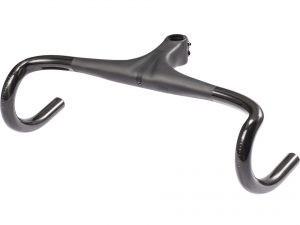No matter what type of ride you are doing, from commuting to long distance road cycling, it’ll be enjoyable if your bike is comfortable. And the good news is there are lots of small tweaks you can make to improve the comfort level of your road bike.
Why is comfort important? Well, it won’t just improve your enjoyment levels, but it’ll also improve your performance. The more comfortable you are, the more efficient you’ll be on your road bike.
If your back and shoulders ache because you are overstretching or using the wrong handlebars, then you won’t be able to perform well, for example.
Here are 10 ways to make your road bike more comfortable.
1. Fit wider tyres and reduce tyre pressure

Firstly, if you are using skinny racing tyres, try swapping them for a wider tyre for some instant comfort. The wider the tyre, the lower you can run the tyre pressure without risking a puncture, and the lower the tyre pressure, the more cushioning you get from the road.
If you are concerned that choosing a wider tyre might sacrifice speed, you shouldn’t be. Wider tyres can actually improve speed and plenty of the Pro Tour riders opt for 25mm tyres today, rather than the typical 23mm tyres.
Check what tyre width your bike wheels allow as there are some limiting factors, such as disc brakes.
2. Upgrade your saddle

One of the most common road bike components that can significantly impact comfort is your saddle. If the one that came with your bike isn’t comfortable, consider changing it.
Some riders like a softer and larger saddle, some prefer a cutaway centre to remove pressure, and others prefer a harder and thinner saddle. It’s all about preference. Try some out and find the one that suits your best.
3. Double up on your bar tape
On long rides, particularly if it’s over rough terrain, it’s important to ensure your hands and wrists are comfortable. The best way to do this is to add another layer of bar tape, which is easy to do yourself, and will give you an additional bit of padding to take away the worst road vibrations.
If that’s not enough and your hands and wrists are still aching, try putting shock-absorbing gel inserts underneath your bar tape.
4. Change your handlebar

There are loads of options when it comes to handlebars. When you buy a road bike, the handlebars that come with them will be the width that works for most people who buy that sized frame, but that doesn’t mean it will suit you.
The handlebar width can be made wider and narrower to accommodate your preference. Additionally, the distance of the drop on the handlebar can also vary, as does the height and the reach.
Making sure you get the right reach (which is the distance between your bottom bracket and your handlebars) is vital to overall bike comfort. If you are over-extending, you’ll get pain in your back, shoulders and neck. Equally important is the height, which if wrong can result in a very uncomfortable ride. If you aren’t very flexible, setting up the wrong handlebar height and reach will result in poor performance and injury.
5. Switch your stem
Likewise to handlebars, stems coming in a variety of sizes, so you can change your riding position to your preference. For example, if you think your handlebar is too far away, a shorter stem will reduce your reach. If you feel like you are hunching, add a spacer to raise the stem.
6. Use proper cycling shorts and gloves

If you haven’t invested in some proper cycling shorts and cycling gloves, it’s worth the money to provide some added comfort. Proper cycling shorts will make a huge difference, particularly on longer rides.
While cycling gloves will keep your hands warm and absorb some of the vibrations from the handlebar.
7. Invest in chamois cream
You might not like the sound of chamois cream, which basically acts as a lubricant to prevent chafing and friction, but it’s a game-changer. Apply chamois cream and it’ll reduce the chances of saddle sores, as well as reduce friction.
8. Check your saddle height and the angle
A saddle that’s too high will put too much strain on your lower back, hamstrings and quads. It can lead to IT band syndrome. A saddle that’s too low is less likely to cause serious strain, but it will massively compromise your performance. Make sure you set the saddle height up properly, based on your inside leg measurements.
Additionally, changing the angle of your saddle can help combat pain in your sensitive areas. To relieve some of the pain, try lowering the angle of the saddle slightly. The downside is more pressure on your arms, so don’t be tempted to angle the saddle too much down.
9. Adjust your cleat positioning
Cleats connect your feet to the pedals and play one of the most significant roles when it comes to comfort. If your cleats are in the wrong position, it means your foot is attached to the pedal in the wrong position, which can lead to ankle, knee and hip pain.
If you are experiencing discomfort, change up the positioning of the cleats to ensure they are in line with the ball of your foot and angled straight.

10. Have a proper bike fit or buy a new bike
Lastly, if you still can’t get your bike to feel comfortable or you’re struggling to alter some of the points above, a professional bike fit can help massively to make sure everything is set up and tailored to you.
What that means is a specialist fitter will set up all the components based on your measurements and preferences. Alternatively, if you’ve got the wrong size frame or simply the wrong bike, you could get a fitting when buying a new bike.
If you do decide to go down this route and get a new road bike, make sure someone gives you an assessment so you get the right size this time. No matter how nice the bike, if it’s not the right size, then it’s no good for you.
Conclusion
Hopefully our tips will help you make your road bike more comfortable. Try them out and let us know how it goes.

Founder of Vivi Nation, the cycling, running and active living brand. Chris is a sports enthusiast, occasional triathlete and experienced cyclist, having led multiple cycle tours across Europe.


